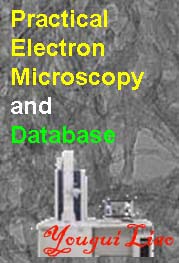
Chapter/Index: Introduction | A | B | C | D | E | F | G | H | I | J | K | L | M | N | O | P | Q | R | S | T | U | V | W | X | Y | Z | Appendix
| Electron spectroscopic diffraction (ESD) in an energy-filtering electron transmission microscope (EFTEM) is used to record electron diffraction patterns with selected energy windows. Based on the theory described by Reimer etc. [1], the angular intensity distribution of inelastically scattered electrons from element i can be given by a
two-dimensional convolution, For a complex material, the total elastic cross-section of the components in the material can be evaluated by summing all the cross-sections of the elements (see page4424). Figure 3505a shows the radial intensity of the diffraction pattern of a 27 nm amorphous Ge film: (a) unfiltered, (b) zero-loss-filtered and (c) plasmon-loss-filtered (ΔE = 17 eV).
Figure 3505b shows two-dimensional (2D) convolution of a radial zero-loss intensity distribution by the inelastic differential cross section for energy losses of ΔE = 1 and 17 eV.
[1] L. Reimer, I. Fromm, I. Naundorf, Electron spectroscopic diffraction, Ultramicroscopy, 32 (1990) 80-91.
|